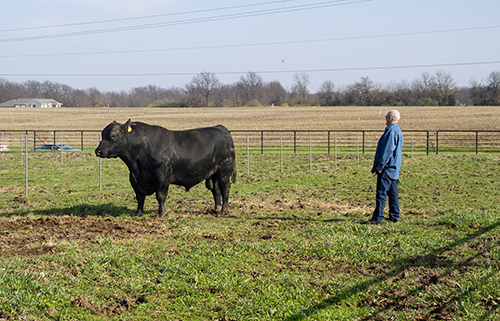iGENDEC: A Tool for Web-Based Sire Selection
Collaborative effort seeks to allow users to build their own selection indexes customized according to individual production environments, objectives and markets.
Collaboratively, academia and industry have done a tremendous job of increasing scientific knowledge and developing tools that cattle producers can apply to genetic selection. That’s how Matt Spangler sees it. However, the University of Nebraska beef cattle geneticist laments the fact relatively few producers actually use the readily available tools.
 |
Web-based sire-selection tool will allow a producer to input data from their operation to create an index for ranking bulls according to how each might be expected to affect the profitability of the enterprise, explained Matt Spangler, University of Nebraska beef cattle geneticist. Photo by Shauna Rose Hermel. |
“Despite the advancements in technology, adoption is embarrassingly poor,” stated Spangler during the 2020 Beef Improvement Federation Symposium, hosted online June 8-12. In a session addressing advancements in selection decisions, he cited data suggesting fewer than 30% of beef cattle producers use expected progeny difference (EPD) values to aid selection. EPDs have been around for a long time — close to 40 years — but effectively using so many different numbers representing many different genetic traits can be downright difficult.
The purpose of Spangler’s presentation was to introduce a new selection tool that promises to help producers make selection decisions that will better enhance returns on their investments in genetics. Dubbed iGENDEC, which stands for internet genetic decisions, this tool is designed to allow users to generate customized selection indexes that will help them make the most economical decisions.
Spangler admitted the selection index concept is not new. Various selection indexes have been developed by breed associations and some private entities to facilitate simultaneous multiple-trait selection to will enhance production and marketing goals. Each index represents a collection of trait EPDs weighted by their economic value such that traits with greater effects on the goals receive greater emphasis. Different indexes address different combinations of goals, and thus include different combinations of traits and assign different levels of emphasis for each trait.
While he is a fan of selection indexes, Spangler admitted they have shortcomings. Existing indexes are widely available and robust, but they are generalizations. Each assumes a common breeding objective and constant environmental and marketing conditions. Each producer must choose an index that “most nearly” fits his or her own situation. Another drawback is that, like EPDs, selection indexes typically are breed-specific.
While producer feedback reflects belief in the concept, existing selection indexes may not be well-understood. Producer adoption remains relatively low.
Spangler explained that iGENDEC will allow users to build their own selection indexes customized according to the producers’ individual production environments, specific production objectives and markets. A producer can input data from their operation, such as breed or breeds used, marketing plan, feed costs and more, and create an index for ranking bulls according to how each might be expected to affect the profitability of the enterprise. Producers may also choose to weight certain traits differently than in standardized indexes. Additionally iGENDEC will allow for more seamless across-breed comparisons of seedstock candidates.
“The impetus is not a belief that currently available selection indices are flawed or of little value,” stated Spangler. “But allowing producers to take part in the creation of their own selection indices has the potential to increase technology adoption.”
In addition to Spangler, the iGENDEC team of researchers includes Bob Weaber, Kansas State University; Warren Snelling, Mark Thallman and Larry Kuehn, U.S. Meat Animal Research Center; and Bruce Golden, of Theta Solutions.
To access the archived presentation slides and webinar session, click here. For more information about this year’s symposium, including additional award winners and coverage of meeting, visit the Awards and Newsroom pages of BIFconference.com. For more information about BIF, visit BeefImprovement.org.
Editor’s Note: This summary was written under contract or by staff of ANGUS MEDIASM. To request reprint permission, please contact Shauna Rose Hermel, Angus Beef Bulletin editor, at 816-383-5270, or Julie Mais, Angus Journal editor, at 816-383-5271. PowerPoints are posted with permission of the presenter and may not be reproduced in whole or in part without the express permission of the presenter. We welcome educational venues and cattlemen to link to this site as a service to their audience.
BIFconference.com is a meeting coverage site provided by Angus Media. Coverage is made possible through the generous contributions of our site sponsors, including American Angus Association, AngusLinkSM, Albrecht Ranch, Branch View Angus Ranch, CattleVisions, Connealy Angus, Deer Valley Farm, Express Ranches, Fink Beef Genetics, Genex, Krebs Ranch, Nichols Farms, Penz Angus Ranch, Pollard Farms, Select Sires, Spur Ranch, Sydenstricker Genetics, and Yon Family Farms. For questions about this site, or to notify us of broken links, click here.
For questions about this site, or to notify us of broken links, click here.Look for additional coverage in the Angus Journal, the Angus Beef Bulletin, the Angus Journal Daily, and the Angus Beef Bulletin EXTRA.


